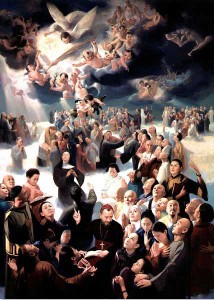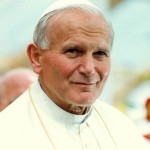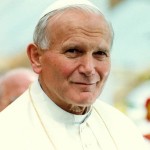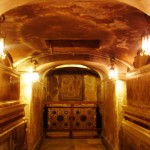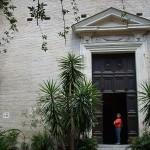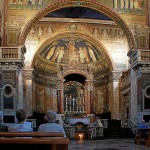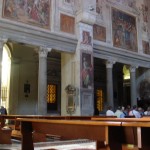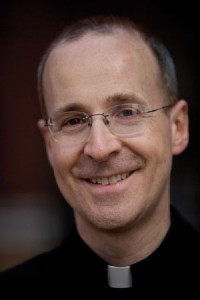
Join Bruce and I, as we discuss the life of both St. Maximilian Kolbe and St. Teresa Benedicta of the Cross with Fr. James Martin, S.J.
[powerpress]
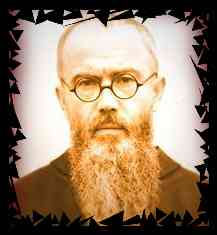 Just look at his eyes…every picture of St. Maximillan Kolbe has those fiery prophetic eyes.
Just look at his eyes…every picture of St. Maximillan Kolbe has those fiery prophetic eyes.
Fueled with the fires of grace from his great love for and devotion to the Blessed Virgin Mary, St. Maximilian was a missionary extraordinaire. A publisher who was a leader in the yet to be defined “New Evangelization”.
They say the blood of the martyrs becomes the seed for the Church. In the case of St. Maximilian, Catholic publishing and broadcasting…all media, would be enriched by his intercession and example. His courage in speaking out against the horrors of the Nazi regime is what placed him in the death camp; it would be his love for Christ and his neighbor that would lead him to give his life for another. And that is what earned him the martyr’s crown.
“In order to discourage escapes, Auschwitz had a rule that if a man escaped, ten men would be killed in retaliation. In July 1941 a man from Kolbe’s bunker escaped. The dreadful irony of the story is that the escaped prisoner was later found drowned in a camp latrine, so the terrible reprisals had been exercised without cause. But the remaining men of the bunker were led out.
‘The fugitive has not been found!’ the commandant Karl Fritsch screamed. ‘You will all pay for this. Ten of you will be locked in the starvation bunker without food or water until they die.’ The prisoners trembled in terror. A few days in this bunker without food and water, and a man’s intestines dried up and his brain turned to fire.
The ten were selected, including Franciszek Gajowniczek, imprisoned for helping the Polish Resistance. He couldn’t help a cry of anguish. ‘My poor wife!’ he sobbed. ‘My poor children! What will they do?’ When he uttered this cry of dismay, Maximilian stepped silently forward, took off his cap, and stood before the commandant and said, ‘I am a Catholic priest. Let me take his place. I am old. He has a wife and children.’
Astounded, the icy-faced Nazi commandant asked, ‘What does this Polish pig want?’
Father Kolbe pointed with his hand to the condemned Franciszek Gajowniczek and repeated‘I am a Catholic priest from Poland; I would like to take his place, because he has a wife and children.’
Observers believed in horror that the commandant would be angered and would refuse the request, or would order the death of both men. The commandant remained silent for a moment. What his thoughts were on being confronted by this brave priest we have no idea. Amazingly, however, he acceded to the request. Apparantly the Nazis had more use for a young worker than for an old one, and was happy to make the exchange. Franciszek Gajowniczek was returned to the ranks, and the priest took his place.
Gajowniczek later recalled:
 I could only thank him with my eyes. I was stunned and could hardly grasp what was going on. The immensity of it: I, the condemned, am to live and someone else willingly and voluntarily offers his life for me – a stranger. Is this some dream?
 I was put back into my place without having had time to say anything to Maximilian Kolbe. I was saved. And I owe to him the fact that I could tell you all this. The news quickly spread all round the camp. It was the first and the last time
For that such an incident happened in the whole history of Auschwitz. A long time I felt remorse when I thought of Maximilian. By allowing myself to be saved, I had signed his death warrant. But now, on reflection, I understood that a man like him could not have done otherwise. Perhaps he thought that as a priest his place was beside the condemned men to help them keep hope. In fact he was with them to the last.’‘
A personal testimony about the way Maximilian Kolbe met death is given by Bruno Borgowiec, one of the few Poles who were assigned to render service to the starvation bunker. He told it to his parish priest before he died in 1947:
 ‘The ten condemned to death went through terrible days. From the underground cell in which they were shut up there continually arose the echo of prayers and canticles. The man in-charge of emptying the buckets of urine found them always empty. Thirst drove the prisoners to drink the contents. Since they had grown very weak, prayers were now only whispered. At every inspection, when almost all the others were now lying on the floor, Father Kolbe was seen kneeling or standing in the centre as he looked cheerfully in the face of the SS men.
Father Kolbe never asked for anything and did not complain, rather he encouraged the others, saying that the fugitive might be found and then they would all be freed. One of the SS guards remarked: this priest is really a great man. We have never seen anyone like him ..
Two weeks passed in this way. Meanwhile one after another they died, until only Father Kolbe was left. This the authorities felt was too long. The cell was needed for new victims. So one day they brought in the head of the sick-quarters, a German named Bock, who gave Father Kolbe an injection of carbolic acid in the vein of his left arm. Father Kolbe, with a prayer on his lips, himself gave his arm to the executioner. Unable to watch this I left under the pretext of work to be done. Immediately after the SS men had left I returned to the cell, where I found Father Kolbe leaning in a sitting position against the back wall with his eyes open and his head drooping sideways. His face was calm and radiant ..’
 So it was that Father Maximilian Kolbe was executed on 14 August, 1941 at the age of forty-seven years, a martyr of charity. The death certificate, as always made out with German precision, indicated the hour of death 12.30.
Father Kolbe’s body was removed to the crematorium, and without dignity or ceremony was disposed of, like hundreds of thousands who had gone before him, and hundreds of thousands more who would follow.
The heroism of Father Kolbe went echoing throughAuschwitz. In that desert of hatred he had sown love. A survivor Jozef Stemler later recalled: ‘In the midst of a brutalization of thought, feeling and words such as had never before been known, man indeed became a ravening wolf in his relations with other men. And into this state of affairs came the heroic self-sacrifice of Father Kolbe.’ Another survivor Jerzy Bielecki declared that Father Kolbe’s death was ‘a shock filled with hope, bringing new life and strength … It was like a powerful shaft of light in the darkness of the camp.’
The cell where Father Kolbe died is now a shrine. Maximilian Kolbe was beatified as Confessor by Paul VI in 1970, and canonized as Martyr by Pope John Paul II in 1981.†– from St. Maximillian Kolbe, saint of Auschwitz
Tags: auschwitz, blessed virgin mary, catholic, catholic podcast, catholic prayer, catholic priest, cathollc spirituality, children, edith stein, father kolbe, fr. james martin, holacaust, James Martin, martyrs, maximillan kolbe, Maximillian Kolbe, nazi death camp, st maximilian
This entry was posted on Thursday, August 14th, 2014 at 6:01 pm
You can follow any responses to this entry through the RSS 2.0 feed.
Fr. James Martin joined us to share the compelling story of St. Charles Lwanga and the Martyrs of Uganda.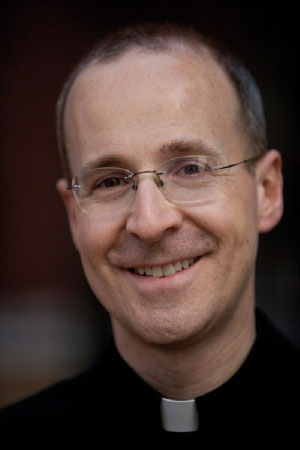
[powerpress]
 Owing to religious hatred, many faithful Christians were killed in Uganda by King Mwanga during the years 1885-87. some of them had enjoyed the good graces of the king at his court, and some were even related to him. Among them, Charles Lwanga and his twenty one companions, adhering steadfastly to the Catholic faith, were put to death, some by sword, others by burning, because they would not accede to the king’s unreasonable demands.
Owing to religious hatred, many faithful Christians were killed in Uganda by King Mwanga during the years 1885-87. some of them had enjoyed the good graces of the king at his court, and some were even related to him. Among them, Charles Lwanga and his twenty one companions, adhering steadfastly to the Catholic faith, were put to death, some by sword, others by burning, because they would not accede to the king’s unreasonable demands.
Father, You have made the blood of the martyrs the seed of Christians. May the witness pf Saint Charles and his companions and their loyalty to the Christ in the face of torture inspire countless men and women to live the Christian faith. We ask this through our Lord Jesus Christ, Your Son, who lives and reigns with You and the Holy Spirit, one God, for ever and ever. Amen.
(Source:Â Liturgy of the Hours)
Tags: africa, america, american magazine, Charles Lwanga, holy spirit, jesuits, Lord Jesus Christ, martyrs, Saint Charles, ugandan martyrs
This entry was posted on Monday, June 3rd, 2013 at 2:35 am
You can follow any responses to this entry through the RSS 2.0 feed.
(Vatican Radio) The destructive force of calumny was the focus of Pope Francis’ homily for MassÂ
celebrated with staff from the Vatican’s telecommunications office and internet services. Emer McCarthy reports:
[powerpress]
The Pope drew inspiration from the daily readings, in particular the first reading that recounts the episode of Stephen, the first martyr of the Church, being dragged before the Sanhedrin because of his witness to the Gospel. Pope Francis noted that Stephen was a victim of calumny. He is accused of “false witness†but it is not a “fair fight, a fight between good menâ€, noted Pope Francis, because Stephen’s enemies chose the path of a dirty fight, “the path of calumnyâ€. Calumny he continued is worse than sin – it is the direct expression of Satan.
“We are all sinners; all of us. We all commit sins. But calumny is something else. It is of course a sin, too, but it is something more. Calumny aims to destroy the work of God, and calumny comes from a very evil thing: it is born of hatred. And hate is the work of Satan. Calumny destroys the work of God in people, in their souls. Calumny uses lies to get ahead. And let us be in no doubt, eh?: Where there is calumny, there is Satan himself. ”
From the behaviour of the accusers, Pope Francis then turned his attention to the accused. Stephan, he noted, does not return falsehood with falsehood: “He does not want to go that way to save himself. He looks to the Lord and obeys the law”, being in the peace and truth of Christ. And that Pope Francis said “is what happens in the history of the Church”, because from the first martyr until today there have been numerous examples of those who have witnessed to the Gospel with great courage:
“But the age of martyrs is not yet over, even today we can say, in truth, that the Church has more martyrs now than during the first centuries. The Church has many men and women who are maligned through calumny, who are persecuted, who are killed in hatred of Jesus, in hatred of the faith: some are killed because they teach the catechism, others are killed because they wear the cross … Today, in many countries, they are maligned, they are persecuted … they are our brothers and sisters who are suffering today, in this age of the martyrs”.
And again Pope Francis repeated “The age of martyrs is not yet over, the Church has more martyrs now than during the first centuries”. This age of “such great spiritual turmoil†reminded the Pope of an ancient Russian icon that depicts Our Lady covering the people of God with her mantle:
“We pray to Our Lady to protect us, and in times of spiritual turbulence the safest place is under the mantle of Our Lady. She is the mother who takes care of the Church. And in this time of martyrs, she is the protagonist, the protagonist of protection: She is the Mother. (…) Let us state with faith: Mother, the Church is under your protection: Care for the Church. ‘”
Text from page http://en.radiovaticana.va/news/2013/04/15/pope:_calumny_destroys_the_work_of_god_in_people/en1-682926
of the Vatican Radio website
Tags: Church, martyrs, Pope Francis, work
This entry was posted on Saturday, April 27th, 2013 at 12:13 pm
You can follow any responses to this entry through the RSS 2.0 feed.
Sunday 1 October 2000 (excerpt taken from vatican.va)
2. “The precepts of the Lord give joy to the heart” (Responsorial Psalm). These words of the Responsorial Psalm clearly reflect the experience of Augustine Zhao Rong and his 119 companions, martyrs in China. The testimonies which have come down to us allow us to glimpse in them a state of mind marked by deep serenity and joy.
Today the Church is grateful to her Lord, who blesses her and bathes her in light with the radiant holiness of these sons and daughters of China. Is not the Holy Year the most appropriate moment to make their heroic witness shine resplendently? Young Ann Wang, a 14-year-old, withstood the threats of the torturers who invited her to apostatize. Ready for her beheading, she declared with a radiant face: “The door of heaven is open to all”, three times murmuring: “Jesus”. And 18-year-old Chi Zhuzi, cried out fearlessly to those who had just cut off his right arm and were preparing to flay him alive: “Every piece of my flesh, every drop of my blood will tell you that I am Christian”.
The other 85 Chinese men and women of every age and state, priests, religious and lay people, showed the same conviction and joy, sealing their unfailing fidelity to Christ and the Church with the gift of their lives. This occurred over the course of several centuries and in a complex and difficult era of China’s history. Today’s celebration is not the appropriate time to pass judgement on those historical periods: this can and should be done elsewhere. Today, with this solemn proclamation of holiness, the Church intends merely to recognize that those martyrs are an example of courage and consistency to us all, and that they honour the noble Chinese people.
Resplendent in this host of martyrs are also the 33 missionaries who left their land and sought to immerse themselves in the Chinese world, lovingly assimilating its features in the desire to proclaim Christ and to serve those people. Their tombs are there as if to signify their definitive belonging to China, which they deeply loved, although with their human limitations, and for which they spent all their energies. “We never wronged anyone”, Bishop Francis Fogolla replied to the governor who was preparing to strike him with his sword. “On the contrary, we have done good to many”. (In Chinese) God sends down happiness.
Tags: Augustine Zhao Rong, catholic, catholic podcast, catholic prayer, cathollc spirituality, china, Church in China HOMILY, martyrdom, martyrs, martyrs in China, Responsorial Psalm, St. Augustine Zhao Rong
This entry was posted on Monday, July 9th, 2012 at 8:09 am
You can follow any responses to this entry through the RSS 2.0 feed.
Join Bruce and I as we discuss with Mike Aquilina the powerful and at the same time, poignant witness of the Holy Roman 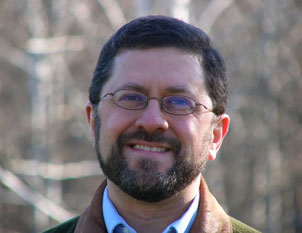 Martyrs[powerpress]
Martyrs[powerpress]
From Mike’s great website The Way of the Matyrs: ROMAN PROTOMARTYRS
Monday June 30th 2008, 10:23 am
Filed under: PatristicsToday’s the feast of the first Roman Martyrs. Theirs is a story you just have to hear. But first we have to backtrack a little bit.
In July of A.D. 64, during the tenth year of Nero’s reign, a great fire consumed much of the city of Rome. The fire raged out of control for seven days — and then it started again, mysteriously, a day later. Many in Rome knew that Nero had been eager to do some urban redevelopment. He had a plan that included an opulent golden palace for himself. The problem was that so many buildings were standing in his way — many of them teeming wooden tenements housing Rome’s poor and working class.
The fire seemed too convenient for Nero’s purposes — and his delight in watching the blaze didn’t relieve anybody’s suspicions. If he didn’t exactly fiddle while Rome burned, he at least recited his poems. Nero needed a scapegoat, and an upstart religious cult, Jewish in origin and with foreign associations, served his purposes well. Nero, who was a perverse expert at human torment, had some of its members tortured till they were so mad they would confess to any crime. Once they had confessed, he had others arrested.
He must have known, however, that the charges would not hold up. So he condemned them not for arson, or treason, or conspiracy, but for “hatred of humanity.â€
To amuse the people, he arranged for their execution to be a spectacle, entertainment on a grand scale. The Roman historian Tacitus (who had contempt for the religion, but greater contempt for Nero) describes in gruesome detail the tortures that took place amid a party in Nero’s gardens.
Mockery of every sort was added to their deaths. Covered with the skins of beasts, they were torn by dogs and perished, or were nailed to crosses, or were doomed to the flames. These served to illuminate the night when daylight failed. Nero had thrown open the gardens for the spectacle, and was exhibiting a show in the circus, while he mingled with the people in the dress of a charioteer or drove about in a chariot. Hence, even for criminals who deserved extreme and exemplary punishment there arose a feeling of compassion; for it was not, as it seemed, for the public good, but to glut one man’s cruelty, that they were being punished.
That is all we know about the first Roman martyrs. We know none of their names. Tacitus doesn’t tell us why they were willing to die this way rather than renounce their faith. Yet this should be an important question for us to consider. Why did the martyrs do this? What prepared them to face death so bravely? To what exactly did they bear witness with their death?
The answers to these questions (and many more) can be found in the rest of the article, at the archive of Touchstone Magazine. The article originated in a talk I gave in Rome in 2005 on the feast of the Roman Martyrs. It’s called “The Roman Martyrs and Their Mass.â€
I also treat the subject in my book The Resilient Church: The Glory, the Shame, & the Hope for Tomorrow.
Tags: catholic, catholic podcast, catholic prayer, cathollc spirituality, Holy Roman Martyrs, martyrdom, martyrs, mike aquilina, Roman Martyrs, rome
This entry was posted on Saturday, June 30th, 2012 at 10:47 am
You can follow any responses to this entry through the RSS 2.0 feed.
an excerpt from Pope John Paul II’s homily….
 MASS FOR THE CANONIZATION OF KOREAN MARTYRS
Youido Place – Seoul
Sunday, 6 May 1984“Was it not necessary that the Christ should suffer these things and enter into his glory“? (Luc. 24, 26)
3. The truth about Jesus Christ also reached Korean soil. It came by means of books brought from China. And in a most marvellous way, divine grace soon moved your scholarly ancestors first to an intellectual quest for the truth of God’s word and then to a living faith in the Risen
Savior.
Yearning for an ever greater share in the Christian faith, your ancestors sent one of their own in 1784 to Peking, where he was baptized. From this good seed was born the first Christian community in Korea, a community unique in the history of the Church by reason of the fact that it was founded entirely by lay people. This fledgling Church, so young and yet so strong in faith, withstood wave after wave of fierce persecution. Thus, in less than a century, it could already boast of some ten thousand martyrs. The years 1791, 1801, 1827, 1839, 1846 and 1866 are forever signed with the holy blood of your Martyrs and engraved in your hearts.
Even though the Christians in the first half century had only two priests from China to assist them, and these only for a time, they deepened their unity in Christ through prayer and fraternal love; they disregarded social classes and encouraged religious vocations. And they sought ever closer union with their Bishop in Peking and the Pope in faraway Rome.
After years of pleading for more priests to be sent, your Christian ancestors welcomed the firstFrench missionaries in 1836. Some of these, too, are numbered among the Martyrs who gave their lives for the sake of the Gospel, and who are being canonized today in this historic celebration.
The splendid flowering of the Church in Korea today is indeed the fruit of the heroic witness of the Martyrs. Even today, their undying spirit sustains the Christians in the Church of silence in the North of this tragically divided land.
4. Today then it is given to me, as the Bishop of Rome and Successor of Saint Peter in that Apostolic See, to participate in the Jubilee of the Church on Korean soil. I have already spent several days in your midst as a pilgrim, fulfilling as Bishop and Pope my service to the sons and daughters of the beloved Korean nation. Today’s Liturgy constitutes the culminating point of this pastoral service.
For behold: through this Liturgy of Canonization the Blessed Korean Martyrs are inscribed in the list of the Saints of the Catholic Church. These are true sons and daughters of your nation, and they are joined by a number of missionaries from other lands. They are your ancestors, according to the flesh, language and culture. At the same time they are your fathers and mothers in the faith, a faith to which they bore witness by the shedding of their blood.
From the thirteen-year-old Peter Yu to the seventy-two-year-old Mark Chong, men and women, clergy and laity, rich and poor, ordinary people and nobles, many of them descendants of earlier unsung martyrs – they all gladly died for the sake of Christ.
Listen to the last words of Teresa Kwon, one of the early Martyrs: “Since the Lord of Heaven is the Father of all mankind and the Lord of all creation, how can you ask me to betray him? Even in this world anyone who betrays his own father or mother will not be forgiven. All the more may I never betray him who is the Father of us all”.
A generation later, Peter Yu’s father Augustine firmly declares: “Once having known God, I cannot possibly betray him”. Peter Cho goes even further and says: “Even supposing that one’s own father committed a crime, still one cannot disown him as no longer being one’s father. How then can I say that I do not know the heavenly Lord Father who is so good?”.
And what did the seventeen-year-old Agatha Yi say when she and her younger brother were falsely told that their parents had betrayed the faith? “Whether my parents betrayed or not is their affair. As for us, we cannot betray the Lord of heaven whom we have always served”. Hearing this, six other adult Christians freely delivered themselves to the magistrate to be martyred. Agatha, her parents and those other six are all being canonized today. In addition, there are countless other unknown, humble martyrs who no less faithfully and bravely served the Lord.
5. The Korean Martyrs ave borne witness to the crucified and risen Christ. Through the sacrifice
of their own lives they have become like Christ in a very special way. The words of Saint Paul the Apostle could truly have been spoken by them: We are “always carrying in the body the death of Jesus, so that the life of Jesus may also be manifested in our bodies . . . We are always being given up to death for Jesus’ sake, so that the life of Jesus may be manifested in our mortal flesh”.
The death of the martyrs is similar to the death of Christ on the Cross, because like his, theirs has become the beginning of new life. This new life was manifested not only in themselves – in those who underwent death for Christ – but it was also extended to others. It became the leaven of the Church as the living community of disciples and witnesses to Jesus Christ. “The blood of martyrs is the seed of Christians“: this phrase from the first centuries of Christianity is confirmed before our eyes. (more…)
Tags: catholic, catholic podcast, catholic prayer, cathollc spirituality, martyrs
This entry was posted on Tuesday, September 20th, 2011 at 10:13 am
You can follow any responses to this entry through the RSS 2.0 feed.
Second Thursday of Advent IÂ – from the Gospel of Matthew the full reading and reflection
“He is Elijah who is to come”
an excerpt from today’s reflection by Don Schwager:
God may call some of us to be martyrs for our faith in Christ. But for most of us our call is to be dry martyrs who bear testimony to the joy of the gospel in the midst of daily challenges, contradictions, temptations and adversities which come our way as we follow the Lord Jesus. What attracts others to the gospel? When they see Christians loving their enemies, being joyful in suffering, patient in adversity, pardoning injuries, and showing comfort and compassion to the hopeless and the helpless. Jesus tells us that we do not need to fear our adversaries. He will give us sufficient grace, strength, and wisdom to face any trial and to answer any challenge to our faith. Are you eager to witness to the joy and freedom of the gospel?
“Lord Jesus, by your cross you have redeemed the world. Fill me with joy and confidence and make me a bold witness of your saving truth that others may know the joy and freedom of the gospel.”
for the full reflection visit : Daily Reading and Meditation
Tags: advent, catholic, catholic podcast, catholic prayer, cathollc spirituality, don schwager, gospel of matthew, john the baptist, martyrs
This entry was posted on Thursday, December 9th, 2010 at 6:23 am
You can follow any responses to this entry through the RSS 2.0 feed.
 St. Andrew Dung Lac and Companions
St. Andrew Dung Lac and Companions
Nov 24th, 2010 by Omar F. A. Gutierrez (check out Regnum Novum)
Today marks the Memorial of the Martyrs of Vietnam often referred to as the Memorial of Andrew Dung Lac and Companions. This is an interesting memorial in that the number of martyrs commemorated include about 117 names of known martyrs but also the untold thousands whom we do not know. Furthermore, the memorial is for martyrs from various times in Vietnam’s history, from the 17th through the 20th centuries.The memorial was set by Pope John Paul the Great on June 19th, 1988. He canonized 117 Vietnamese but noted that there were somewhere between 130,000 to 300,000 martyrs for the Catholic faith in that nation. The suffering of these people has been astounding. In the 19th century, when persecution of Catholics was at its worst, entire villages of Vietnamese were slaughtered by the regime. The reason given was that the Catholics were involved in political revolutions, attempting to put a Catholic-friendly ruler into power. Being Catholic, then, became a crime, and, echoing the years of Christian persecution in Ancient Rome, Vietnamese were called upon to stomp on a crucifix to prove that they were not Christian. Those who refused were tortured horribly and then killed. The lucky ones were only branded on their faces with the Vietnamese words for “perverse religion.â€
During the fall of Vietnam to Communist rule in the 20th century and of course due to the war, many Vietnamese fled their homeland and came to the United States. Interestingly, since about 1977, the American Vietnamese community has had a four-day celebration in little Carthage, Missouri dedicated to Our Lady and in celebration of their heritage and faith. The Marian Days Festival happens every year in the summer and the small Missouri town is inundated with upwards of 50,000 Vietnamese who celebrate Mass together, sing to Our Lady of Fatima, and eat really good Vietnamese food.
This memorial to the Vietnamese Martyrs ought to remind us of one of the greatest of Vietnamese Catholics, Cardinal Francis Xavier Nguyen Van Thuan. Cardinal Francis Xavier, as he liked to introduce himself, had a meteoric rise in Vietnam as a young man. The son of very devout Catholic parents, he was extremely bright. He earned advanced degrees in theology, philosophy, and canon law all by the time he was in his early twenties.
He eventually became the coadjutor bishop of Saigon in 1975. Six days later, Saigon fell to the North Vietnamese, and the Cardinal was thrown into prison. He spent thirteen years there, nine of them in solitary confinement. While in confinement a village boy would bring him paper, and Cardinal Van Thuan would write down some encouraging word or phrase. These messages from the Cardinal in prison helped bouey the people for which he was still a shepherd. They have since then been compiled into the books The Road to Hope and Prayers of Hope.
He was released from prison in 1988, the same year as the canonization of the Vietnamese Martyrs. He was allowed to leave for Rome in 1991, but was then never allowed back by the government…that is until 2001.
While in Rome, he made many impressions on people, not the least of these being Pope John Paul the Great. It was that Holy Father who in 1994 elevated the little bishop from Vietnam to be President of the Pontifical Council of Justice and Peace and made him a Cardinal.
In 1999, in the document to us Ecclesia in America (The Church in America), John Paul wrote:
54. Faced with the grave social problems which, with different characteristics, are present throughout America, Catholics know that they can find in the Church’s social doctrine an answer which serves as a starting-point in the search for practical solutions. Spreading this doctrine is an authentic pastoral priority. … In this regard, special care must be taken to train lay persons capable of working, on the basis of their faith in Christ, to transform earthly realities. In addition, it will help to promote and support the study of this doctrine in every area of the life of the particular Churches in America, especially in the universities, so that it may be more deeply known and applied to American society. The complex social reality of the continent is a fruitful field for the analysis and application of the universal principles contained in this doctrine.
To this end, it would be very useful to have a compendium or approved synthesis of Catholic social doctrine, including a “Catechismâ€, which would show the connection between it and the new evangelization.
It was then up to Cardinal Nguyen Van Thuan to try to make heads or tails out of the vast array of social documents and social commentary, to try to bring together people from vastly different political and social backgrounds, to try to – in Herculean manner – build an edifice for the Social Doctrine of the Church that would at once stand the test of time but also be relevant to our lives here and now. This was no small task, but it was his.
The Compendium we have now is a splendid work which accomplishes everything that the good Cardinal desired. Unfortunately, he died before its completion in 2002. Still the preliminary work and guidance which he provided proved decisive for the construction of one of the most useful tools for the social doctrine that exists. Cardinal Van Thuan’s process for canonization was opened in 2007, having met the minimum 5 years. Pope Benedict XVI actually mentions Cardinal Van Thuan in his second encyclical Spe Salvi as a “witness to hope.â€
So on this day of remembrance for the Vietnamese Martyrs, remember them, remember Cardinal Francis Xavier Nguyen Van Thuan, and remember to be thankful for the great peace and tranquility that our culture affords us in being able to pray freely.
I’ll leave you with the ten rules of life by which the Cardinal lived. Go here to learn more.
 1. I will live the present moment to the fullest.
1. I will live the present moment to the fullest.
2. I will discern between God and God’s works.
3. I will hold firmly to one secret: prayer.
4. I will see in the Holy Eucharist my only power.
5. I will have only one wisdom: the science of the Cross.
6. I will remain faithful to my mission in the Church and for the Church as a witness of Jesus Christ.
7. I will seek the peace the world cannot give.
8. I will carry out a revolution by renewal in the Holy Spirit.
9. I will speak one language and wear one uniform: Charity.
10. I will have one very special love: The Blessed Virgin Mary.
Oh and this:
I am happy here, in this cell, where white mushrooms are growing on my sleeping mat, because You are here with me, because You want me to live here with You. I have spoken much in my lifetime: now I speak no more. It’s Your turn to speak to me, Jesus; I am listening to You.
Recorded on the Feast of the Holy Rosary, October 7, 1976, in Phu-Khanh prison during his solitary confinement. Regnum Novum
 Thanks one again Omar G. for an outstanding contribution to our on going formation!
Thanks one again Omar G. for an outstanding contribution to our on going formation!
Tags: Andrew Dung Lac, Cardinal Francis Xavier Nguyen Van Thuan, Cardinal Nguyen Van Thuan, catholic, catholic podcast, catholic prayer, cathollc spirituality, christian persecution, martyrs, pope john paul, pope john paul the great, vietnamese community
This entry was posted on Wednesday, November 24th, 2010 at 8:20 am
You can follow any responses to this entry through the RSS 2.0 feed.
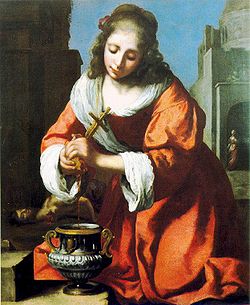 Today is the feast of one of my favorite “sister” saints, St. Praxedes. I found out about her when I went a pilgrimage a couple of years ago to Rome led by Scott and Kimberly Hahn and Mike Aquilina. It is believed that she, and her sister St. Pudentiana, were the daughters of St. Pudens (from 2 Timothy 4:21). She and her sister are remembered as saints of true mercy.Â
Today is the feast of one of my favorite “sister” saints, St. Praxedes. I found out about her when I went a pilgrimage a couple of years ago to Rome led by Scott and Kimberly Hahn and Mike Aquilina. It is believed that she, and her sister St. Pudentiana, were the daughters of St. Pudens (from 2 Timothy 4:21). She and her sister are remembered as saints of true mercy.Â
They lived in those early years of the Church, at a time of extreme Christian persecution. They hid Christians in their homes and visited the imprisioned. They even gathered the bodies of the dead after they were brutalized in the Coliesuum, and hid them in a well until they could be properly buried. St. Praxedes is 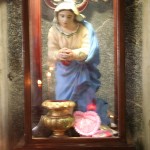 often depicted in art with a sponge soaked in blood; recalling how they cared for the precious blood of the martyrs after their awful executions. Their heoic virtue during these horrific years was so great that almost 2000 years later we still remember them.
often depicted in art with a sponge soaked in blood; recalling how they cared for the precious blood of the martyrs after their awful executions. Their heoic virtue during these horrific years was so great that almost 2000 years later we still remember them.
Their home was one of the first “house churches” in Rome. It is named after her sister, St. Pudentiana. Later another church was built and dedicated to St. Praxedes. Both are located near St. Mary Major in Rome. Click on the pictures to have a better look…
.
.
.
.
.
.
.
.
.
Tags: catholic, catholic podcast, catholic prayer, cathollc spirituality, churches in rome, martyrs, pilgrimage, saints
This entry was posted on Wednesday, July 21st, 2010 at 8:07 am
You can follow any responses to this entry through the RSS 2.0 feed.

